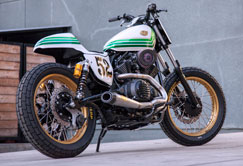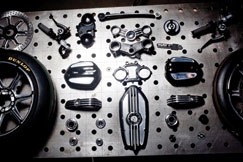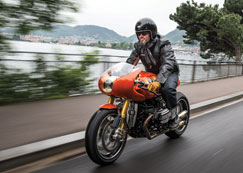Motorcycling is in Roland Sands’ blood.
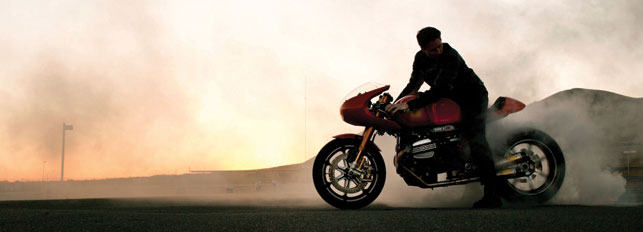
Having received his first motorcycle at just five years old, he spent much of his childhood and teenage years in the motorcycle machine shop his dad owned in Long Beach, California.
Surrounded by tools, CNC machines and custom motorcycles in various stages of being built, he soon started to design his own custom and racing parts.
“I was helping develop and design racing brake systems and magnesium wheels as well as developing the in-house testing mechanisms so I got a big schooling in the entire product development process. I was also the lead test rider for the products and was fortunate to have won a championship on a product I helped develop,” says Sands.
That championship was the AMA 250cc GP national championship, which he won in 1998 riding a Team Performance Machine Yamaha. But in 2005 after ten years of racing and setting track records all around the world (some of which he still holds) and over 30 broken bones later, he decided to hang up his racing helmet and founded Roland Sands Design (RSD).
“I have no formal engineering training but I’ve seen a lot of product failures. I think that having looked at the right way of doing something for so long you get a real gut feel for what works and what does not.
“So I took all that experience with me when I stopped racing. I needed to put that energy into something creative and fun with two wheels. The RSD brand is a result of that.”
Set up shop
RSD is located in Los Alamitos, California, not far from where Sands grew up. The facility includes a design office where he sketches his ideas for not only custom motorcycles, parts and accessories but RSD branded apparel too, some of which is sold in the on-site retail store.
There is also a fully set up workshop with a team of builders and fabricators who all come from various motorcycling backgrounds whether it be building bikes or riding them.
“We have a rapid prototyping machine in-house, which has become a necessity and really speeds things up. We used to have CNC capabilities in-house but that got expensive, so it’s easy to get that outsourced,” says Sands.
RSD builds about ten one-off custom motorcycles a year either as personal projects or builds for partners and customers.
For instance, it recently completed a customisation project of the Yahama Bolt. The machine has a simple layout and Sands and his team were able to make it unique through a few modifications and tweaks.
Now complete, it’s ended up somewhere between a café racer and a flat tracker. “I’ve been wanting to build a streetable tracker for a while and it was crazy how this bike just accepted that route so well.
“We didn’t do a huge amount of mods: zero cutting of anything; stock tank; glass tail; fabbed side number plates and front number plate; removed the headlight; added 19-inch wheels and flattrack tyres. We then bolted on an RSD pipe, exhaust, pegs, bars, risers and grips. That’s about it,” he says.
Motorcycle part design
It’s these custom builds that help grow RSD’s accessory line, which is the core of its business. “Many hard part ideas actually start off as prototypes on one of our custom bikes. That’s the easiest way to develop an RSD part, the natural way.”
RSD’s motorcycle parts line up consists of just about every part available to help motorcyclists customise their bikes from foot pegs and RSD-branded gas caps to headlights and seats.
Just this year, RSD has already introduced 180 new hard parts including motorcycle seats for Mustang, a new exhaust line and parts to extend existing lines.
“I’m involved with the design of every single part. I wish there were rooms of dudes doing it, but as it is there’s only one other guy I work with on design. His name is Rodney and he’s a pain in the arse but I love him,” smiles Sands.
Ideas for new parts come from many places. Outside of the workshop that can be nature, photos seen on Instagram or even graffiti, whilst inside inspiration comes from bike builds, a gap in an existing product line or customer requests.
“It really comes down to a solid product plan and rationalisation to decide what we put effort into, but sometimes it’s just a gut feeling about something we love.”
Sands starts off by sketching his ideas and discussing these with his team. He primarily uses pen and paper but moves quickly into SolidWorks, Photoshop and Illustrator. He is also eagerly awaiting the arrival of a new Wacom tablet with its interactive pen display.
“Sketching/painting with a mouse sucks, but I’m still a little old school and we work by any means necessary,” he says.
This ‘any means necessary’ philosophy carries through to the workshop where the sketched idea is developed further. “We use paper, wire, parts off the shelf – all kinds of stuff just to start the visual cues we need to make decisions.
“We don’t have the time or budgets to talk about a design for weeks or do clay or foam to find our way. It’s more of a get it done philosophy. We go straight to metal.”
Although many of the parts are prototyped in-house using the RP machine, all manufacturing is outsourced to high quality partners. “Post all the manufacturing we bring the product to market and figure out how to sell it,” says Sands.
BMW Concept Ninety
Although Sands can mostly be found in either the design office or getting his hands dirty in the workshop, lately he has been travelling in Europe promoting the BMW Concept Ninety.
Launched in May 2013 during the Concorso d’Eleganza Villa d’Este 2013, an annual vintage car event on the shores of Lake Como, Italy, this sporty boxer was a collaboration between BMW Motorrad’s design team in Rosenheim, Germany, and RSD.
BMW Motorrad wanted to build a concept that would honour two anniversaries – BMW Motorrad’s 90th and the 40th of the iconic BMW R 90 S, one of the fastest production bikes of its day reaching a speed of 124 mph.
The brief was for this high performance motorcycle concept to embody the spirit of its emotionally charged forebear but to also push into the future with new technologies and cutting-edge parts.
Edgar Heinrich, head of BMW Motorrad Design, and Ola Stenegard, head of vehicle design BMW Motorrad, both keen motorcyclists (see page 13), knew just the man who could help them do this. In fact, they had been talking to Sands about doing a project together for some time and this was the perfect opportunity to bring their collective (petrol) heads together.
“For the Concept Ninety, BMW wanted something outside of the normal BMW stationary concepts, they wanted it to be a runner and more of a customised concept and it had to happen fast. Ola knew we could get it done… or I promised him we could and he believed me,” laughs Sands.
Back & forth, back & forth
BMW came up with the initial rendering and then it was a case of back and forth as Sands added his own ideas and flavour to the design.
Not being in the same office, or even the same country and time zone for that matter, would normally be seen as a major challenge but Sands admits it was a surprisingly smooth process.
“Ola and I were communicating constantly, every day for like two months we were on the phone. In the end we really agreed on nearly every aspect of the design, so that part was easy.”
Once the designs were finalised, BMW provided Sands with the CAD data to get the parts fabricated.
Although BMW was very forthcoming in providing these files, not all OEMs are.
“BMW were awesome to work with and they aided in the engineering and supplied base models. Other OEMs haven’t been so easy to work with as they don’t want to release files. That’s hard because in the end you’re doing a project to help them succeed,” comments Sands.
“It’s pretty tough to guess your way through a 3D surface when you’re dealing with critical interference and potential engine failure if you get it wrong. That said, we have to do it all the time, and that’s when rapid prototyping helps.”
Key highlights of the BMW Concept Ninety include the front cover of the engine, the valve covers and the exhaust system, all of which bear the signature RSD imprint. The round headlamp design harks back to the predecessor, although it was halogen then and LED now.
Many of the parts were milled using a contrast cut process, which is in striking contrast to the black mechanical components.
Just two months and 18 machined parts later, the build was complete.
A highlight of the project and payback for all those late nights spent working on it, was the opportunity Sands had to thrash it round the track before the launch.
“It was fun and inspirational working with Ola and the BMW crew. Today I realise it was more of an experience than just a project. I think that genuine bond really showed in the build and is a major part of the success of the bike,” admits Sands.
Love to ride
So, back in RSD’s Californian HQ, with the business growing and new parts to design, does Sands still find time to get out and ride?
“I ride as often as I can. What I really love is riding off road – no cops, nature and pure two-wheeled freedom. I’m planning a trip to Baja California in September with two friends who run the charity Waves for Water. We’ll be searching for surf breaks, delivering water filters to those in need of fresh water and exploring the Baja. Should be epic.”
rolandsands.com | bmw-motorrad.com
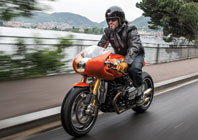
Roland Sands and the design and development of the BMW Concept Ninety
Default


